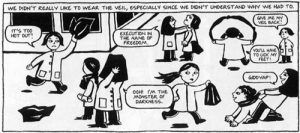In Marjane Satrapi’s graphic narrative Persepolis, debate over the requirement and impact of the hijab (or “veil”, as Satrapi refers to it) is present from the very first page, when she says “we didn’t really like to wear the veil, especially since we didn’t understand why we had to.” Throughout the book, Satrapi is vocal about how the hijab was utilized as a form of oppression during her upbringing in post-Islamic Revolution Iran.

However, in response to the French government’s debate over banning the hijab in 2003, she takes a different angle: “I also think that to forbid girls from wearing the veil, … is to be every bit as repressive. … I have been incredibly surprised by the reaction of French feminists, who have publicly campaigned for the banning of ‘this visible symbol of the submission of women,’” (https://www.theguardian.com/world/2003/dec/12/gender.uk).
This statement resonated with me all week, especially in today’s context of the Me Too movement and increasing sexual assault awareness. I have often wrestled with the idea that, by not covering up, women are asking to be objectified. This mindset is seen in many sexual assault cases where the victim is minimized with the statement “she was asking for it”.
In the vast majority of cases, I do not see any truth in the statement that women who “show off” their body are asking for objectification. (What girl has ever thought “oh yes, PLEASE treat me like an object instead of a human being”?) Rather, I think that society has socialized males to think that. So if a male sees a female “showing off” her body, he has been socialized to interpret it to mean that she is seeking objectification or sexual attention.
Some approaches to feminism find the solution to this to be dressing however you want anyway, and being comfortable in your own skin despite the objectification that may be a result. Other approaches solve this by covering up, and lessening the possibility of being objectified. But is either REALLY a solution?
In my view, the only real solution is to teach males not to objectify women no matter what. Males should be taught that the way a girl dresses, looks, acts, etc. does NOT say anything about what she wants, and the only thing that says anything about what she wants is what she actually says.
Is a girl oppressed because she chooses to wear a hijab? No. Is a girl oppressed because she chooses to wear a miniskirt? No. Can both be oppressive when used as a way to control or devalue women? Definitely (as Satrapi points out in Persepolis). Really, the issue is much deeper than clothes; it is the way that males are socialized to think of the other sex that comes from the deep rooted patriarchal elements that still exist is society. Referring to the hijab as a “symbol of the submission of women” comes from the same place as saying a sexual assault victim “was asking for it” because she wore a short skirt, and both are equally destructive towards women. So rather than attacking women for their clothing choices, shouldn’t we be trying to break the causes of objectification?